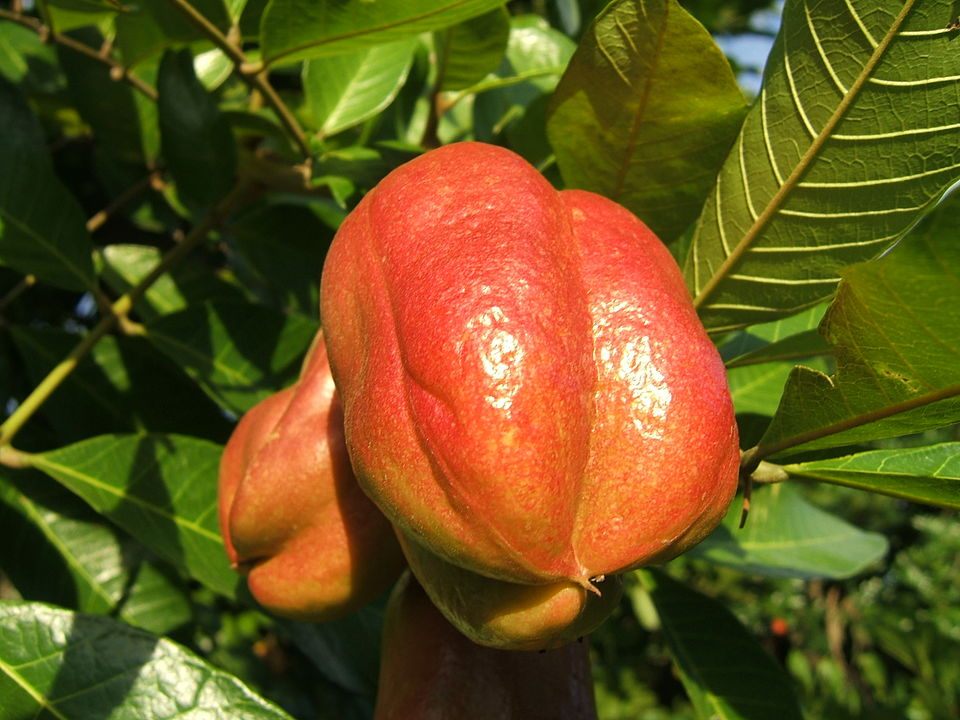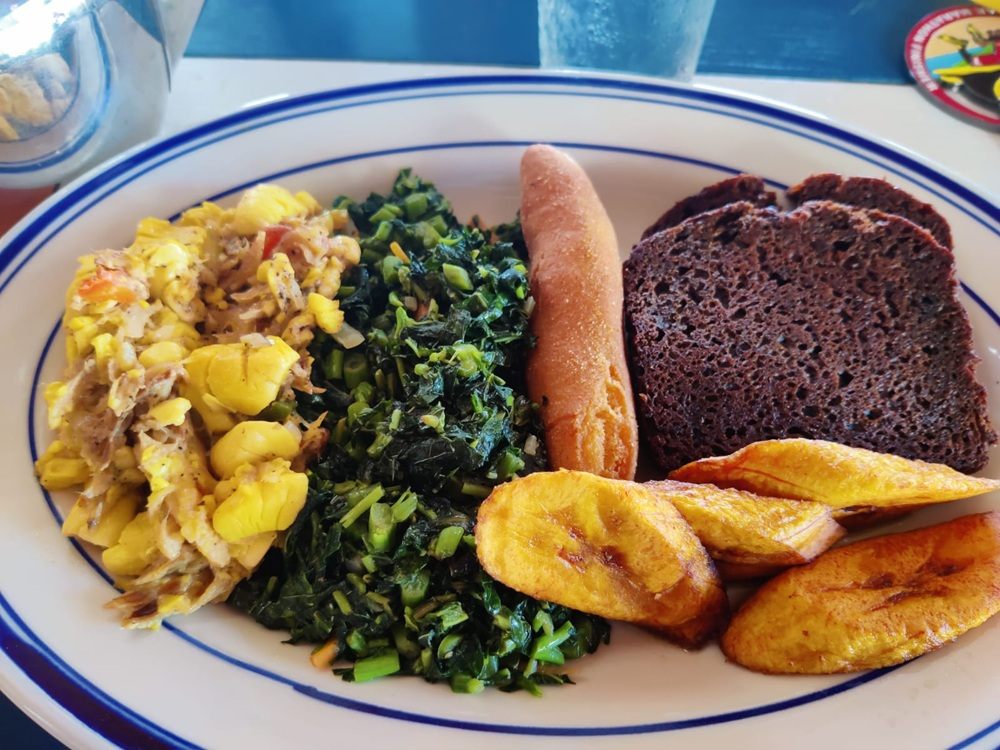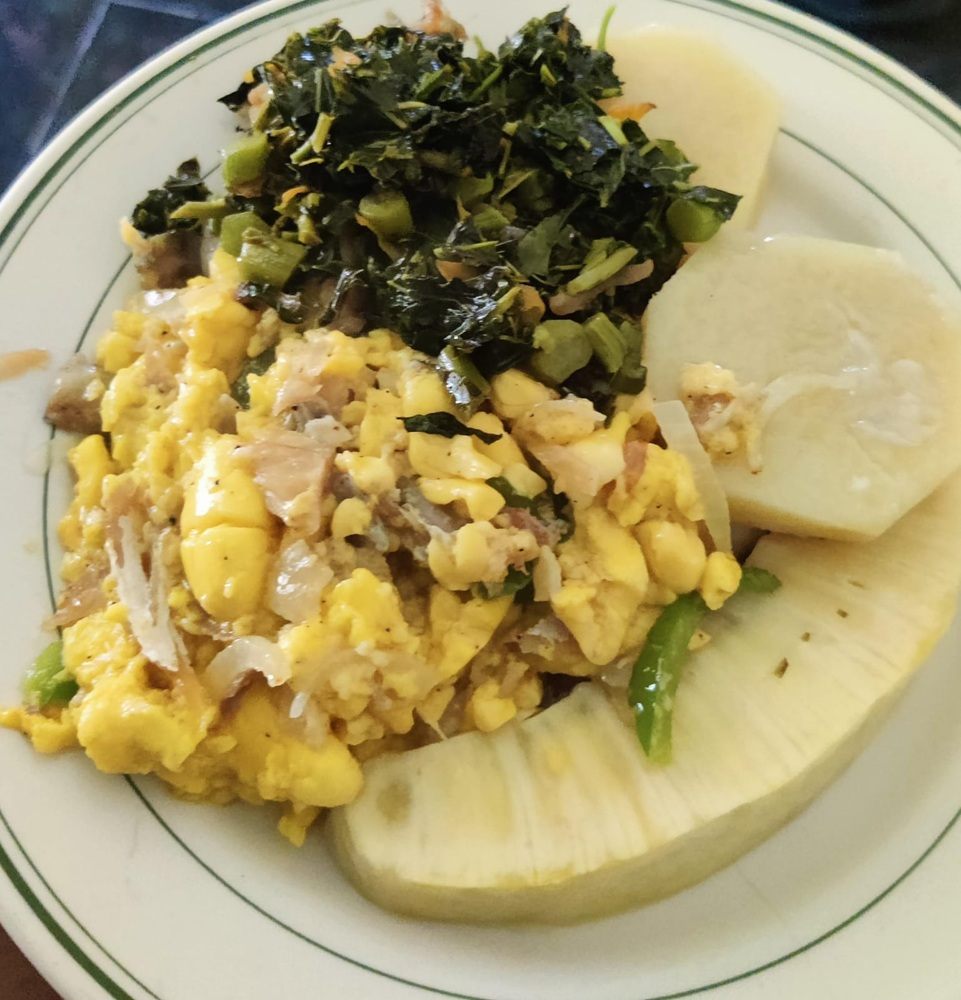When you think of Jamaican cuisine, what comes to mind? Bold spices, vibrant colors, and dishes that sing with tropical flavor. Jamaican food is a celebration of culture, history, and rhythm — and at the heart of this culinary heritage are two beloved ingredients: ackee and callaloo.
Whether you’re a seasoned foodie or just beginning your journey into Caribbean cooking, ackee and callaloo offer a delicious and nutritious taste of Jamaica. Traditionally served for breakfast but enjoyed at any time of day, this dish blends soft, buttery ackee with leafy, nutrient-rich callaloo — a match made in island heaven.
And here’s the best part: it’s easy to adapt! From the classic callaloo ackee and saltfish version to a wholesome vegan ackee and callaloo recipe, there’s a plate for every preference.
Ready to cook up a true taste of the islands? Let’s dive into the flavors of Jamaica, one bite at a time.
What Is Ackee and Callaloo? A Taste of Jamaican Culture
If you’ve ever heard someone rave about Jamaican ackee and callaloo, it’s for good reason. This flavorful duo isn’t just a meal — it’s a cultural icon, deeply rooted in Jamaica’s culinary history.
What Is Ackee?

Ackee is Jamaica’s national fruit. Originally from West Africa, it was brought to the island during the 18th century and has since become a staple of Jamaican cooking. When ripe and properly prepared, ackee has a creamy, buttery texture and a mild, nutty flavor that’s often compared to scrambled eggs — making it a perfect plant-based alternative in vegan dishes.
Note: Only the ripe, yellow arils of the ackee are edible; the unripe fruit is toxic and must be handled properly.
What Is Callaloo?
Callaloo refers to leafy green vegetables commonly used in Caribbean cooking. In Jamaica, callaloo is usually made from amaranth or taro leaves, and it’s cooked down with onions, garlic, peppers, and thyme into a savory, earthy dish. It’s rich in iron, fiber, and flavor — a nutritious powerhouse on the plate.
Why Combine Ackee and Callaloo?
While ackee and saltfish may be Jamaica’s official national dish, combining ackee and callaloo brings together two locally beloved ingredients in a lighter, often vegan-friendly way. This fusion celebrates the island’s agricultural roots and culinary creativity, offering a dish that is both satisfying and symbolic.
From family breakfasts to street-side vendors, ackee and callaloo continue to hold a cherished place in Jamaican kitchens. It’s comfort food with cultural soul — and now, it’s your turn to bring it to life at home.
Traditional Callaloo, Ackee and Saltfish Recipe (With or Without Saltfish)

This traditional callaloo, ackee and saltfish recipe is a classic that brings the essence of Jamaica to your kitchen. Whether you prefer it with the iconic saltfish or want a plant-based twist, this dish is hearty, flavorful, and surprisingly simple to prepare.
Authentic Ingredients
Here’s what you’ll need:
Main Ingredients:
- 1 can of ackee (drained) or 2 cups fresh, properly prepared ackee
- 2 cups callaloo (fresh or frozen)
- 1 medium onion, sliced
- 2 garlic cloves, minced
- 1 bell pepper (red or green), sliced
- 1 scotch bonnet pepper (optional, for heat)
- 2 sprigs of thyme
- 2 scallions, chopped
- 1 tsp black pepper
- 2 tbsp coconut oil
- Salt to taste
Optional (for traditional version):
- ½ lb saltfish (salted cod), soaked and boiled
Step-by-Step Instructions
- Prepare the Saltfish (if using):
Soak saltfish in cold water overnight (or boil it for 20–30 minutes, changing the water once) to remove excess salt. Once soft, shred into bite-sized pieces and set aside. - Cook the Callaloo:
In a large skillet, heat 1 tbsp coconut oil. Sauté onion, garlic, bell pepper, scallion, and thyme until soft and fragrant. Add the callaloo and cook down for about 5–7 minutes. Remove from pan and set aside. - Sauté the Saltfish (or skip for vegan version):
In the same skillet, add another tablespoon of oil. If using saltfish, stir-fry it for 3–5 minutes with the aromatics until lightly crisped. - Add Ackee Gently:
Add drained ackee (or prepared fresh ackee) to the skillet and gently fold it in to avoid breaking the soft flesh. Cook for 3–5 minutes on low heat. - Combine Everything:
Add the cooked callaloo back into the skillet. Mix gently to combine. Adjust seasoning with salt and pepper. - Serve Hot:
Pair with fried dumplings, bammy, boiled green bananas, or rice for a truly Jamaican experience.
Tips for Using Fresh vs. Canned Ackee
- Fresh ackee must be fully ripe and opened naturally on the tree before harvesting. It needs to be cleaned and boiled before eating to remove toxins.
- Canned ackee is precooked and ready to use — ideal for convenience and safety. Drain it carefully to avoid mushy texture.
This callaloo, ackee and saltfish recipe brings the warmth of Jamaica straight to your table. Prefer a plant-based version? Just skip the saltfish and enjoy a rich, satisfying dish that’s naturally vegan and full of Caribbean flavor.
Callaloo, Ackee, and Saltfish: A Classic Jamaican Trio

In many Jamaican households, no weekend breakfast is complete without the iconic trio of callaloo, ackee, and saltfish. This savory blend of textures and flavors is more than just a dish — it’s a cultural staple that represents the island’s rich culinary heritage.
How Saltfish Is Traditionally Added
Saltfish, typically salted cod, is first soaked overnight or boiled to remove excess salt, then shredded and sautéed with onions, garlic, thyme, and scotch bonnet peppers. Once the fish is seasoned and slightly crisped, ackee and callaloo are folded in gently to avoid breaking the ackee’s delicate texture.
This method ensures every bite is perfectly balanced — salty, tender fish, buttery ackee, and earthy greens — all enhanced by Jamaican herbs and spices.
Nutritional Benefits & Taste Profile
This traditional ackee and callaloo recipe offers a rich blend of nutrients:
- Ackee: High in healthy fats and fiber, low in carbs, and rich in vitamin A and zinc.
- Callaloo: Packed with iron, calcium, vitamin C, and antioxidants.
- Saltfish: A good source of protein and omega-3 fatty acids (though high in sodium if not properly soaked).
The flavor profile is warm and savory with a touch of sweetness from the ackee, the leafy bitterness of callaloo, and the umami-rich saltiness of the cod. Together, they create a well-rounded Caribbean flavor experience.
Substitutions for a Modern Twist
- Vegan? Swap saltfish with sautéed mushrooms, jackfruit, or marinated tofu for a plant-based ackee and callaloo recipe that still delivers deep flavor.
- No callaloo available? Use spinach, kale, or Swiss chard as a substitute.
- No saltfish? Use smoked mackerel or a pinch of seaweed for an umami boost.
This timeless callaloo ackee and saltfish dish is endlessly adaptable and deeply satisfying — whether served at a Sunday brunch or as part of a comforting dinner spread.
How to Make Vegan Ackee and Callaloo (Easy & Flavorful)

Craving the taste of the Caribbean without the meat? This vegan ackee and callaloo recipe is the perfect plant-based twist on a Jamaican classic. With the same rich flavors and satisfying textures, it’s proof that you don’t need saltfish to enjoy a truly authentic island experience.
Plant-Based Substitutes That Work
To replace saltfish while keeping the umami depth, try one of these flavorful swaps:
- Mushrooms (oyster or cremini): Sautéed until golden, they bring a meaty bite and savory edge.
- Chickpeas: Add protein and texture with a hint of nuttiness.
- Tofu or jackfruit: Marinated and pan-fried for a chewy, satisfying finish.
These ingredients absorb the spices beautifully and blend well with both ackee and callaloo.
Flavoring with Herbs and Oil
Use coconut oil to sauté your aromatics — onion, garlic, scallion, thyme, and bell pepper — for that unmistakable Jamaican base flavor. Add a hint of scotch bonnet (if you like heat) and a dash of black pepper to bring it all to life.
Even without meat, this easy vegan ackee and callaloo recipe delivers bold, comforting flavor thanks to natural herbs and the creamy richness of ackee.
Serving Suggestions
Pair your vegan ackee and callaloo with:
- Steamed white rice or rice and peas
- Jamaican fried dumplings or festival
- Roasted breadfruit
- Boiled green bananas or sweet plantains
It’s a flexible dish — hearty enough for dinner, comforting enough for brunch, and always 100% satisfying.
Tips for a Delicious Vegan Jamaican Dish
Where to Find Vegan Ingredients
- Ackee: Canned ackee is widely available in Caribbean or international grocery stores, and online.
- Callaloo: Look for fresh callaloo at West Indian markets, or use frozen callaloo as a great alternative. Spinach and kale work too.
- Vegan saltfish substitutes: Mushrooms, jackfruit, and firm tofu can be found in most health food stores.
How to Preserve the Authentic Taste
- Don’t skip the sautéed aromatics — Jamaican dishes are built on bold base flavors.
- Use fresh thyme, scallion, and coconut oil for authenticity.
- Be gentle with the ackee. Fold it in last and stir lightly to keep the creamy texture intact.
Ackee and Callaloo FAQs
Curious about this iconic Jamaican dish? Whether you’re new to Caribbean cuisine or looking to perfect your ackee and callaloo recipe, here are answers to the most common questions people ask — especially through voice search like “Is ackee safe to eat?” or “Can I freeze callaloo?”
Is ackee safe to eat?
Yes — ackee is completely safe to eat when properly prepared. The key is to use only the fully ripe ackee, which opens naturally on the tree. The edible yellow flesh (arils) must be thoroughly cleaned and boiled to remove toxins called hypoglycin A and B.
If you’re not in Jamaica, it’s safest to buy canned ackee, which is precooked and ready to use. Always avoid eating unripe or unopened ackee fruit.
Where can I buy callaloo outside Jamaica?
If you’re outside of the Caribbean, you can find callaloo at:
- Caribbean and West Indian grocery stores
- Some African or international markets
- Online retailers (frozen or canned callaloo)
- Substitute with spinach, kale, or Swiss chard if unavailable
Look for it fresh (in bunches), frozen, or canned — all work well for any ackee and callaloo recipe.
Can I freeze ackee and callaloo?
Yes, you can freeze ackee and callaloo — especially after cooking. Let the dish cool completely, then portion it into airtight containers. It will keep for up to 2 months in the freezer.
To reheat, thaw overnight in the fridge and warm gently on the stovetop to preserve texture.
What are the health benefits of ackee and callaloo?
Both ackee and callaloo are nutrient-rich and make a healthy combination:
- Ackee: High in essential fatty acids, zinc, and vitamin A
- Callaloo: Loaded with iron, calcium, and dietary fiber
- Low in carbs, especially when made without saltfish
- Vegan-friendly and gluten-free when prepared with plant-based ingredients
Together, they create a balanced dish that supports heart health, energy, and digestion.
Serving Suggestions for Ackee and Callaloo
Once your pot of ackee and callaloo is ready, the next step is deciding what to serve with it. This hearty Jamaican dish is incredibly versatile and pairs well with a variety of island-style side dishes — whether you’re making the traditional callaloo ackee and saltfish version or a vegan ackee and callaloo twist.
Best Side Dishes for Ackee and Callaloo
Serve your dish with one (or more) of these classic Jamaican sides for a complete, satisfying meal:
- Fried Dumplings: Crispy on the outside, fluffy on the inside — perfect for scooping up ackee.
- Festival: Slightly sweet cornmeal fritters that balance out the savory richness.
- Bammy: A cassava flatbread that’s lightly fried or steamed.
- Boiled Green Bananas or Yellow Yam: Earthy, starchy, and traditionally Jamaican.
- Hard Dough Bread: Dense, buttery bread that soaks up all the flavor.
- Rice & Peas: A popular choice, especially for lunch or dinner portions.
When to Serve Ackee and Callaloo
- Breakfast or Brunch: Traditionally served on weekends or special occasions.
- Lunch or Dinner: Hearty enough to be a main course, especially with sides.
- Cultural Celebrations: A must-have at Jamaican Independence Day, family gatherings, or Caribbean festivals.
Final Thoughts on Cooking Ackee and Callaloo at Home
Whether you’re planning a weekend brunch or a dinner party with Caribbean flair, ackee and callaloo is always a crowd-pleaser.
Whether you’re recreating a taste of home or exploring Jamaican flavors for the first time, ackee and callaloo offers a rich and rewarding culinary experience. This dish is more than just food — it’s a connection to tradition, community, and comfort.
Traditional or Vegan — There’s a Version for Everyone
- Want something classic? Try the callaloo, ackee and saltfish combo for a true taste of Jamaica.
- Prefer plant-based? The vegan ackee and callaloo recipe delivers all the flavor, with none of the fish.
Both variations are deeply satisfying, easy to make, and full of nutrients and Caribbean soul.
Have you tried cooking ackee and callaloo at home? Leave a comment below and share your experience! Did you go the traditional route or try the vegan twist? We’d love to see your creations.
